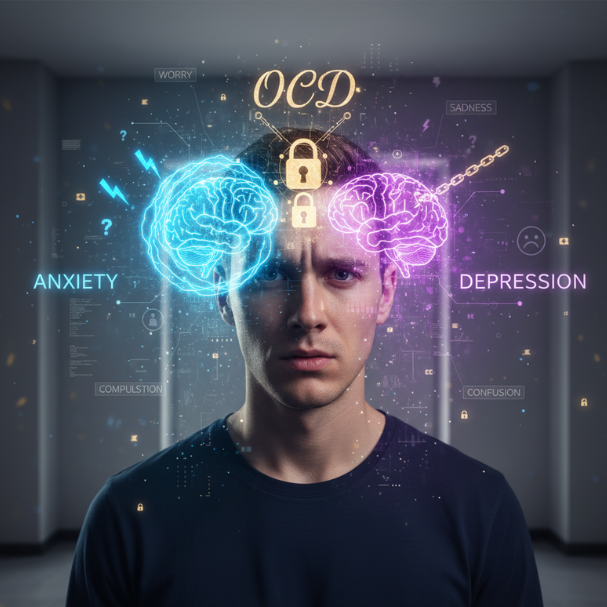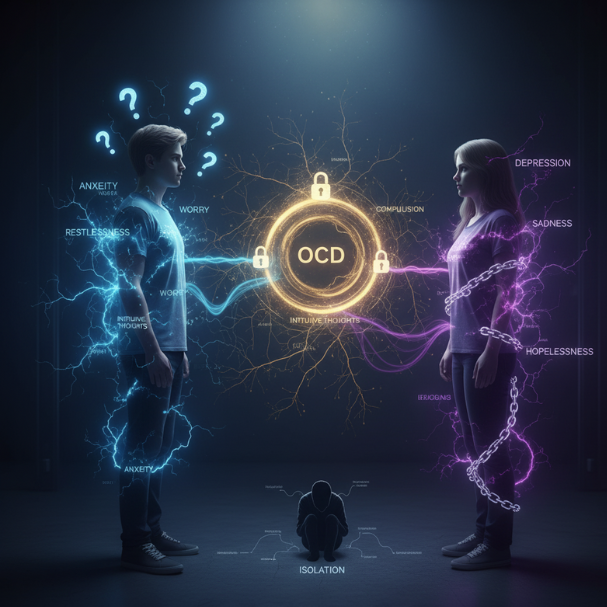Mental health challenges often do not occur in isolation. Many individuals experience what professionals refer to as co-occurring mental health disorders. Among the most common combinations are anxiety, depression, and obsessive-compulsive disorder (OCD). When these conditions overlap, they can intensify one another and create a cycle that makes it more difficult for individuals to cope with daily life. Understanding how these disorders interact, what contributes to their co-existence, and how individuals can navigate them is essential in building awareness and reducing stigma.
What Are Co-Occurring Mental Health Disorders?
Co-occurring mental health disorders, sometimes called comorbid conditions, occur when a person experiences two or more mental health challenges at the same time. Unlike physical illnesses that can be diagnosed and treated separately, mental health disorders often overlap in symptoms, making it more complicated to identify where one ends and the other begins. For example, a person with anxiety may also show signs of depression, and someone with OCD may experience heightened levels of anxiety that feed into compulsive behaviors.

The co-occurrence of these conditions is not rare. In fact, research suggests that a large percentage of people diagnosed with one mental health disorder are likely to have another. This is particularly true for anxiety, depression, and OCD, which share underlying factors such as negative thought patterns, stress sensitivity, and certain personality traits.
The Link Between Anxiety, Depression, and OCD
While anxiety, depression, and OCD are distinct conditions, they are connected in several ways. Anxiety is characterized by excessive worry, restlessness, and fear of future events. Depression involves persistent sadness, loss of interest, and feelings of hopelessness. OCD is defined by intrusive thoughts and repetitive behaviors aimed at reducing distress.
The connection between these disorders lies in how the brain processes fear, stress, and emotional regulation. Anxiety often fuels the development of compulsive behaviors in OCD, while depression can emerge when an individual feels powerless in managing ongoing symptoms of anxiety or obsessive thinking. The three conditions can form a cycle: anxiety triggers intrusive thoughts, compulsive behaviors temporarily reduce distress, but the lack of long-term relief can lead to feelings of despair and depression.
Common Causes and Risk Factors
Co-occurring mental health disorders are shaped by a combination of biological, psychological, and environmental influences. While each person’s experience is unique, several common factors contribute to why anxiety, depression, and OCD may occur together:
-
Genetic predisposition – Family history plays a role in vulnerability to multiple disorders. If close relatives have experienced any of these conditions, the likelihood of developing more than one increases.
-
Brain chemistry – Neurotransmitters, which regulate mood and thought patterns, may become imbalanced. This imbalance can contribute to the overlapping symptoms of anxiety, depression, and OCD.
-
Stressful life experiences – Trauma, prolonged stress, or significant life changes can act as triggers that lead to the onset of multiple disorders.
-
Personality traits – Certain traits, such as perfectionism or high sensitivity to criticism, may increase susceptibility to both anxiety and OCD, which can later lead to depressive episodes.
-
Environmental pressures – Social isolation, lack of support, or high-pressure environments can exacerbate mental health symptoms, making it harder to manage one disorder without another developing.
How Symptoms Overlap
Recognizing co-occurring disorders can be challenging because many symptoms overlap. For example, someone experiencing fatigue and poor concentration may be showing signs of either depression or anxiety. Similarly, obsessive thoughts can feel like anxious rumination, and the emotional distress from OCD may contribute to depressive symptoms.
Some common overlapping symptoms include:
-
Constant feelings of worry or dread
-
Difficulty concentrating or making decisions
-
Irritability or mood swings
-
Changes in sleep patterns
-
Withdrawal from social interactions
-
Persistent intrusive or negative thoughts
While these symptoms may point to one disorder, the presence of multiple signs suggests the possibility of co-occurrence.
Impact on Daily Life
Living with co-occurring mental health disorders can be overwhelming. The conditions often reinforce each other, creating a cycle that makes it harder to function in everyday settings. Anxiety may prevent a person from attending social gatherings, OCD rituals may consume large portions of the day, and depression may drain motivation to engage in work or relationships.
This overlap can lead to challenges such as:
-
Reduced productivity and performance in school or work
-
Strained personal relationships due to misunderstandings
-
Isolation and avoidance of social situations
-
Decreased self-esteem and self-confidence
-
Increased risk of chronic stress and related physical health issues
The Importance of Early Recognition
One of the biggest challenges with co-occurring mental health disorders is delayed recognition. Many people may seek help for one set of symptoms without realizing that another disorder is also present. For example, someone may pursue support for depression but overlook their compulsive behaviors or ongoing anxiety. This makes it essential to raise awareness about how these conditions are interconnected.

Early recognition not only helps individuals understand their mental health better but also improves their chances of learning effective coping strategies. By identifying co-occurrence, people can avoid becoming trapped in cycles of untreated symptoms that worsen over time.
Coping Strategies and Support
Although co-occurring mental health disorders can feel overwhelming, there are practical strategies that can help individuals manage their symptoms and improve their overall well-being. While these approaches are not a replacement for professional help, they provide valuable tools for daily resilience.
1. Building Awareness
Understanding how anxiety, depression, and OCD interact is the first step in managing them. By observing patterns, triggers, and how symptoms influence one another, individuals gain insight into their mental health and can make more informed choices about how to respond.
2. Stress Management Practices
Stress is a common factor that worsens symptoms across all three conditions. Engaging in stress-reducing activities such as mindfulness meditation, yoga, or deep breathing exercises can help calm the mind and reduce intrusive or negative thoughts.
3. Creating a Routine
Establishing a structured daily routine provides a sense of stability. Predictability in daily life can reduce feelings of uncertainty that often fuel anxiety and compulsive behaviors, while also providing motivation that counters depressive symptoms.
4. Support Systems
Social support plays a critical role in managing mental health. Friends, family members, and support groups provide encouragement, reduce feelings of isolation, and offer understanding during difficult times.
5. Healthy Lifestyle Habits
Regular exercise, balanced nutrition, and adequate sleep contribute to emotional resilience. These habits may not eliminate mental health disorders, but they help improve mood, reduce stress, and strengthen the ability to cope with daily challenges.
6. Creative Outlets
Engaging in hobbies, art, journaling, or other forms of creative expression provides an outlet for intrusive thoughts and emotions. These activities also give individuals a sense of accomplishment and can counteract feelings of hopelessness.
Reducing Stigma Around Co-Occurring Disorders
One of the barriers to effective support is the stigma surrounding mental health, especially when multiple conditions are involved. Society often misunderstands mental illness, viewing it as a weakness rather than a complex health issue. This misconception prevents many individuals from seeking the help they need.
Reducing stigma starts with open conversations about mental health. By normalizing discussions of anxiety, depression, and OCD, people can create environments where individuals feel safe sharing their experiences. Education, awareness campaigns, and community initiatives all play vital roles in shifting public perception and fostering compassion.
The Path Forward
Living with co-occurring mental health disorders is not easy, but it is possible to lead a meaningful and fulfilling life. Recognizing that anxiety, depression, and OCD often overlap is the first step toward better self-awareness. Building coping strategies, developing strong support networks, and promoting open discussions about mental health all contribute to breaking the cycle of isolation and misunderstanding.
While these conditions may not disappear overnight, individuals can learn to manage them with resilience and patience. By focusing on mental well-being, cultivating healthy habits, and embracing community support, people can navigate the challenges of co-occurring mental health disorders and move toward a more balanced life.




